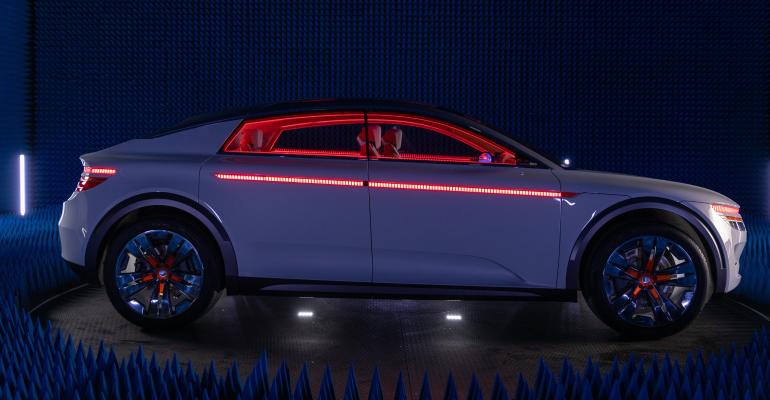LAS VEGAS – Qualcomm Automotive takes a significant leap this week toward advancing the industry’s movement to the software-defined vehicle as well as in furthering its own evolution.
Here at CES 2023, the semiconductor and software-solutions company is showing off its next-generation Snapdragon Ride Flex SoC (System-on-Chip) product family that takes the next step along the path to a unified central-compute vehicle electronics architecture by combining both digital cockpit and advanced driver-assistance system/autonomy processing capabilities onto a single chip.
Available for testing now and expected to be ready for production vehicles by 2024, the new more-powerful Flex SoC provides both performance benefits and cost-savings for OEMs, Qualcomm says. Designed to meet the highest level of automotive safety (ASIL-D), it pre-integrates Qualcomm’s Snapdragon Ride Vision stack that enables scalable ADAS and more advanced automated-driving technology by processing inputs from multiple camera, radar and lidar sensors.
The combination of ADAS/AV and digital-cockpit functions onto a single SoC means automakers will be able to integrate cockpit displays with immersive high-end graphics, infotainment gaming displays and rear-seat entertainment screens concurrently with a latency-critical premium audio experience and the Snapdragon Ride Vision stack, the company says.
That dual-purpose capability will help Qualcomm address the divergent paths the industry currently is on, where some automakers are moving quickly to entirely new SDV-focused electronics architectures and others simply are looking for additional cost reduction through design efficiency, Nakul Duggal, senior vice president and general manager of Qualcomm Automotive, says in an interview ahead of today’s product reveals.
“We are now working with a number of different automakers who are designing their next-generation architectures (where) software is its own independent product and the hardware being a foundation that just has to work,” meaning it can be scaled up, Duggal says.
“And then there are other automakers that simply have economics in mind,” he adds. “The thought process is, ‘If I can actually bring the same (feature) capability at a reduced cost to a much larger number of vehicles, why would I not want to go to that?’”
“So, what you see with Flex is a combination (that meets) the two (OEM requirements).”
The new SoC debuts here alongside a new generation of the Snapdragon Ride Vision platform. Qualcomm says major Tier 1s are sampling that software now and are aiming for introduction in production vehicles by 2025. A long list of suppliers utilizes the Snapdragon Ride Vision software already, including Continental, Haomo AI, Hyundai Mobis, Valeo, ZF, Luminar and others.

The new SoC technology is being demonstrated on a concept car Qualcomm is unveiling here for the first time. The concept is a drivable, full battery-electric vehicle.
“That’s something we’re super excited to showcase,” Duggal says. “It has a single SoC that is powering everything in it. It has a second platform for connectivity, and everything you see in it from productivity applications to safety to collaboration, gaming, audio…are capabilities that have been integrated by our team and our ecosystem partners.
“We build the software platform so it is very easy for our partners to then build on top without making a tremendous amount of change to their specific application,” he says, noting that is what will allow electronic architectures to be reused in future generations of vehicles and still remain current, offering the latest features and capabilities.
With the product advancements, Qualcomm could be taking another step in its evolution to becoming part of what it sees as a newly emerging Tier 1 network – one that is focused more on providing overall solutions, rather than simply supplying hardware
“We see ourselves stepping up into areas where there is a gap, where our capabilities lend themselves to be quite valuable to the automakers and to other Tier 1s as well,” Duggal says of the company’s near-term business objectives. “And it’s really about creating a new ecosystem. I do think that a set of new actors are needed to scale (the SDV) up. You can’t really solve this problem OEM by OEM. It’s too expensive, it will take too long, it’s not going to sustain itself too easily.
“That’s where we feel there’s a shift (in sourcing philosophy), and we see that pattern repeated across many different areas we explore.”





